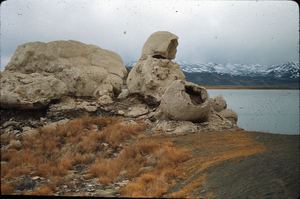Search the Special Collections and Archives Portal
Search Results

Slide of the old stamp mill, circa 1950s
Date
Archival Collection
Description
Image

Slide of the Bowers Mansion, Washoe Valley, Nevada, circa 1970s
Date
Archival Collection
Description
Image

Slide of a tufa deposit in Pyramid Lake, Nevada, circa 1970s
Date
Archival Collection
Description
Image

Slide of the rock formation known as The Squaw and Her Basket, Pyramid Lake, Nevada, circa 1970s
Date
Archival Collection
Description
Image

Los Angeles & Salt Lake Railroad Company double privy: architectural drawing
Date
Archival Collection
Description
From Union Pacific Railroad Collection (MS-00397). The scales are noted in the drawing. The bottom of the drawing says, "Material-Finish: All Finish Lumber Unless Otherwise Noted Shall Be [Opsas?] Wood Work Of Vault Shall Be O.P Rough. Exterior Of Privy Including Both Sides Of Door And Door Jamb: Also Wood Lattice Screen On All Sides Shall Be Painted With 3 Coats C.S. Lead & Oil Paint As Directed. Doors Shall Be Hung On 3 1/2" x 3 1/2" Botts. Doors Shall Be Provided With Rim Latch Knob Lock And Iron Barrel Bolt. Revisions: Added Vent Stacks, Seat Cover, Double Floor & Floor Shoe".
The bottom corner of the drawing states, "Union Pacific System L.A. & S.L.R.R. Double Privy 5'x8' With Lattice Screen. Ass't Chief Engineer's Office. Los Angeles, Calif. Drawn By E.C.B. Traced By E.C.B. Checked By F.W.G. Date June 14, 1926. Scale As Noted. Revised May 5. 1927. Drawing No. 15637".
Also written on the drawing: "Two to be built at East Yard, Calif. One ' ' Big Springs, Nev. ' ' Las Vegas, Nev. ' ' Borden, Utah. ' ' Elgin, Nev. 1927. ' ' Dry Lake, Nev. 1927. ' ' Wann ' ' 1928 [crossed out]."
Image
Luceanne "Lucy" Taufa oral history interview
Identifier
Abstract
Oral history interview with Luceanne "Lucy" Taufa conducted by Jerwin Tiu, Cecilia Winchell, and Stefani Evans on December 16, 2022 for Reflections: the Las Vegas Asian American and Pacific Islander Oral History Project. In this interview, Taufa describes growing up on the Tongan island of Vava'u in a large family and later immigrating to the United States. She recalls her father first immigrating to Hawaii, and after obtaining a green card, her and her siblings following shortly after. While Kaufa's older siblings continued to pursue higher education and her younger siblings were too young to work, she took on a bulk of the responsibility to provide income and navigate life in Hawaii for her family. Eventually, Lucy moved to Dallas, Texas, met her husband, and moved to Las Vegas, Nevada for her husband's job. Later in the interview, she discusses joining the Culinary Union after experiencing racial discrimination at her workplace and her pride in her identity as a Tongan woman.
Archival Collection
Loretta Bowman Collection of Clark County Clerk Records
Identifier
Abstract
The Loretta Bowman Collection of Clark County Clerk Records (1912-1997) contain documents collected by Clark County Clerk Loretta Bowman during her time in office. Materials include court proceedings, signed agreements and contracts, appointments to public offices and related correspondence, denials of cases involving battery on police officers, affidavits for birth certificates, and criminal peace bonds. The majority of the materials are oaths of office and the related surety bonds for government officials.
Archival Collection
University of Nevada, Las Vegas Department of Athletics Records
Identifier
Abstract
The University of Nevada, Las Vegas (UNLV) Department of Athletic Records consist of UNLV sports memorabilia, programs, magazines, media guides, and newsletters from the athletics department. The collection has materials documenting both women and men's teams including basketball, swimming and diving, and golf. Other teams include track and field, cheer and dance, and softball. There are also materials that document Jerry Tarkanian's role coaching the men's basketball team.
Archival Collection
University of Nevada, Las Vegas Phi Kappa Phi Records
Identifier
Abstract
The University of Nevada, Las Vegas Phi Kappa Phi Records (approximately 1960-2019) consist of meeting minutes, correspondence, financial documents, member lists, programs, newspaper clippings, and photographic prints pertaining to the Honor Society of Phi Kappa Phi Chapter 100 at the University of Nevada, Las Vegas (UNLV). The collection also includes memorabilia from the organization's fiftieth induction ceremony, as well as a framed copy of its charter.
Archival Collection

